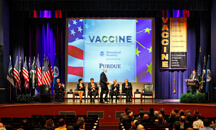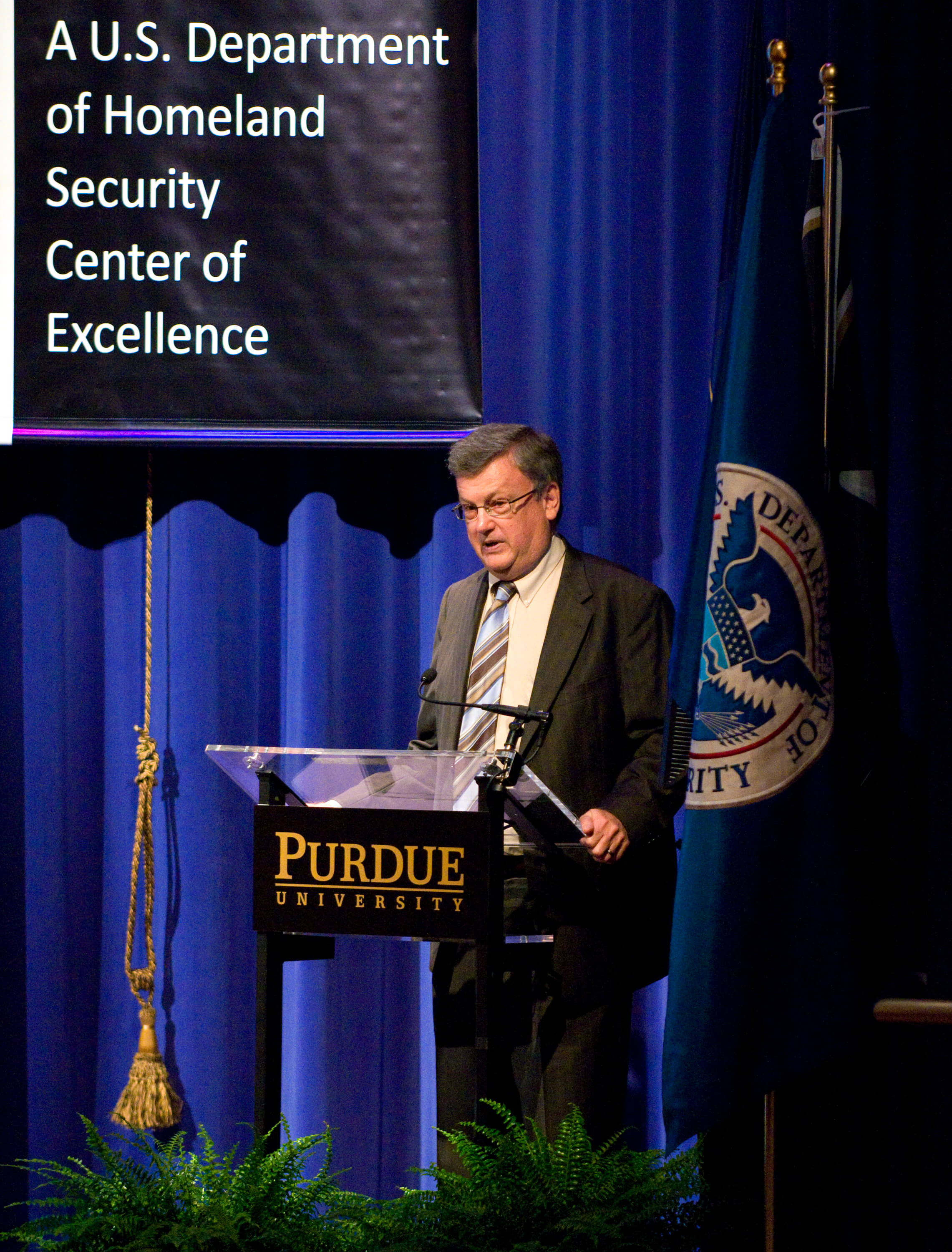Purdue kicks off national center to visualize homeland security data

Purdue officials on Monday (Nov. 9) unveiled a national center to help homeland security and emergency personnel respond to and manage a variety of calamities, from disease outbreaks to economic crises. David Ebert, a Purdue professor of electrical and computer engineering who heads the center (at podium), introduces Starnes Walker, director of research for the U.S. Department of Homeland Security, which funds the Visual Analytics for Command, Control and Interoperability Environments center. From left are U.S. Rep. Stephen Buyer, R-Ind., Purdue President France A. Córdova, U.S. Rep. Mark Souder, R-Ind., Matthew Clark, DHS director of university programs, and Joseph Kielman, DHS chief science adviser. (Purdue University photo/Andrew Hancock)
WEST LAFAYETTE, Ind. - Purdue University on Monday (Nov. 9) will kick off a national center to develop specialized software to help homeland security and emergency personnel respond to and manage a variety of calamities, from disease outbreaks to economic crises.
The new center, called Visual Analytics for Command, Control and Interoperability Environments, or VACCINE, is funded by the U.S. Department of Homeland Security.
"It is imperative that our homeland security personnel and emergency responders have the best possible tools to ensure public safety," said Purdue President France A. Córdova, who will speak during the kickoff. "This center will create tools to turn the sea of data generated during catastrophes into functional information to help emergency personnel perform their jobs more effectively."
Starnes Walker, director of research for the Department of Homeland Security, will speak during the 1:30 p.m. kickoff in Stewart Center's Fowler Hall. Other speakers will include David Boyd, director of the DHS Command, Control and Interoperability Division, Science and Technology Directorate, and U.S. Reps. Mark Souder and Stephen Buyer, both Republicans from Indiana.
VACCINE is one of two parts of a $30 million parent center concentrating on developing new methods to aid homeland security personnel in preparing for, preventing, detecting, responding to and recovering from terrorist attacks as well as natural and human-caused crises. The parent center - the Command, Control and Interoperability Center of Excellence - is co-led by Purdue and Rutgers University.
Purdue and its team of 15 universities will focus on the visualization sciences, while Rutgers will lead efforts in the data sciences component.

U.S. Rep. Mark Souder, R-Ind., speaks Monday (Nov. 9) at Purdue to kick off a new national center to help homeland security and emergency personnel respond to and manage a variety of calamities, from disease outbreaks to economic crises. The new center, called Visual Analytics for Command, Control and Interoperability Environments, is funded by the U.S. Department of Homeland Security. (Purdue University photo/Andrew Hancock)
VACCINE researchers will develop interactive software algorithms that create visualizations, graphics and maps with essential information to help emergency personnel who use a variety of devices, from office desktop computers to mobile phones in the field, said David Ebert, a Purdue professor of electrical and computer engineering who leads VACCINE.
"We are creating ways for people to get information interactively in an understandable format to help them make the right decisions and take preventive measures," Ebert said. "For example, simulations to see what would happen if you were to quarantine a certain city to control the spread of pandemic flu or whether reallocating police patrols would reduce crime."
The visualizations will show concise representations of the key information within massive data streams of information.

Purdue doctoral student Ross Maciejewski uses a type of visualization related to work being led by the university in a new center called Visual Analytics for Command, Control and Interoperability Environments, or VACCINE, funded by the U.S. Department of Homeland Security. Center researchers will develop specialized software to help homeland security and emergency personnel respond to and manage a variety of calamities, from disease outbreaks to economic crises. (Purdue University photo/Andrew Hancock)
Turning large amounts of data into manageable information is vital to homeland security, said Timothy Collins, VACCINE managing director.
"We are talking about creating a visualization and analysis environment for all of the important concerns of the Department of Homeland Security, from dealing with health and safety to border security to critical infrastructure and protection of the food supply," Collins said. "Basically, everything from aviation to zoology."
The visualizations might, for example, show a three-dimensional reconstruction of a building's floor plan and follow the progress of emergency responders moving through the structure to get a better idea of how to deploy them.
"Another application is seeing the effect of pandemic disease spreading across a state," Ebert said. "For example, you will see a map of the state and you can click on a hospital and get graphs of data and projections for the next two weeks of what you can expect, combining graphs and charts, maps, and other representations.
"For contaminated food, you can trace down when and where people first started getting sick, integrating information about the supply chain and the distribution routes. We will create environments where you can say, if this appeared in a store on Friday it was probably shipped from somewhere on Wednesday and probably picked in the fields on Monday, and this is where crops were ripe on Monday."
Such a system likely could help the nation deal more effectively with a contaminated-food crisis, Ebert said.
The center involves about 20 Purdue faculty members and a dozen graduate and undergraduate students from a diverse range of specialties, from computer science and electrical engineering to veterinary medicine and statistics.
VACCINE also has begun forming partnerships with local, state and national groups to provide university researchers real-world examples to help test and refine developing technology. The center will work with several Indiana companies, the Indiana Department of Health, local law enforcement agencies, community colleges and the Law Enforcement Academy of Northeast Indiana, which trains emergency responders.
"We want to develop joint programs that integrate our visualization technology into the two-year training programs," Ebert said.
A previous contract from the Department of Homeland Security Science and Technology Directorate led to the creation of the Purdue University Regional Visualization and Analytics Center, known as PURVAC, in the university's Discovery Park.
Writer: Emil Venere, 765-494-4709, venere@purdue.edu
Sources: David Ebert, 765-494-9064, ebertd@purdue.edu
Tim Collins, 765-494-0434, tfcollins@purdue.edu
